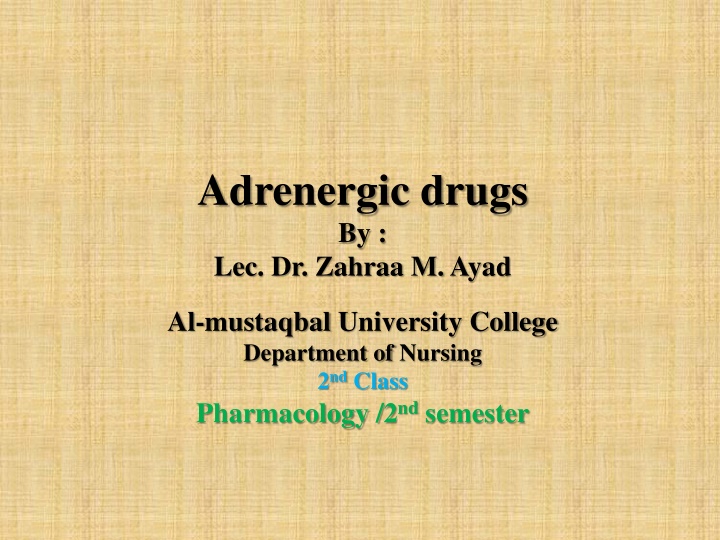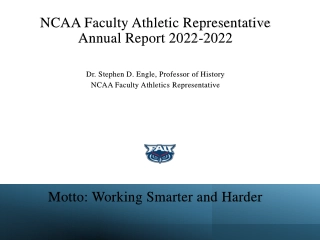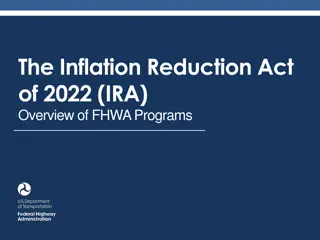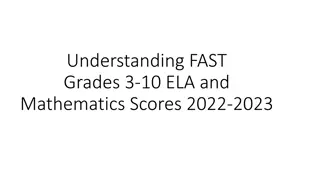Adrenergic Drugs and Receptors in Pharmacology
Adrenergic drugs, also known as sympathomimetic drugs, stimulate adrenergic receptors in the sympathetic nervous system, triggering the fight-or-flight response. These drugs can be agonists or antagonists of the autonomic nervous system. Adrenergic receptors, including alpha and beta receptors, play crucial roles in mediating responses to neurotransmitters like epinephrine and norepinephrine. Different types of adrenergic agonists, such as direct-acting and indirect-acting agonists, have varying mechanisms of action. Overall, understanding the activation and inactivation of adrenergic receptors is essential in pharmacology.
Download Presentation

Please find below an Image/Link to download the presentation.
The content on the website is provided AS IS for your information and personal use only. It may not be sold, licensed, or shared on other websites without obtaining consent from the author.If you encounter any issues during the download, it is possible that the publisher has removed the file from their server.
You are allowed to download the files provided on this website for personal or commercial use, subject to the condition that they are used lawfully. All files are the property of their respective owners.
The content on the website is provided AS IS for your information and personal use only. It may not be sold, licensed, or shared on other websites without obtaining consent from the author.
E N D
Presentation Transcript
Adrenergic drugs By : Lec. Dr. Zahraa M. Ayad Al-mustaqbal University College Department of Nursing 2ndClass Pharmacology /2ndsemester
Adrenergic drugs (Sympathomimetic) Adrenergic drugs stimulate adrenergic receptors, thereby activating the system and inducing symptoms characteristic of the fight-or-flight response stimulation). sympathetic nervous (sympathetic ** Adrenergic agonists stimulate adrenergic receptors of sympathetic nerves. ** Adrenergic antagonists sympathetic division of the autonomic nervous system. inhibit the
Adrenergic Receptors -Alpha receptors ( ) are subdivided into: ( 1) and ( 2) - Beta receptors ( )are subdivided into: ( 1), ( 2) ( 3). - Dopamine receptor. Neurotransmitters - Epinephrine. - Norepinephrine * Adrenergic receptors are inactivated by: - Reuptake of norepinephrine into presynaptic vesicles. inactivation by the enzymes: - monoamine oxidase (MAO). - Catechol-O-methyltransferase (COMT).
Thanks For Listening
Activation of adrenergic receptors leads to: Thanks For Listening
Adrenergic agonist Adrenergic sympathomimetics, adrenergic receptors in the sympathetic nervous system. agonists, are also called activate agents that Mechanism of action of adrenergic agonists 1. Direct-acting agonists. 2. Indirect-acting agonists. 3. Mixed-action agonists.
Sites direct Indirect mixed-acting adrenergic agonists. of action of
1. Direct acting agonist - Mechanism of action: Direct-acting agonists act by binding to adrenergic receptors on effector organs causing sympathetic stimulation. - 2 types of Direct acting agonist: 1) Catecholamines (epinephrine, norepinephrine, dopamine, and dobutamine) All catecholamines have three properties: - they cannot be used orally. - they have a brief duration of action. - they cannot cross the blood-brain barrier.
A. Epinephrine (Adrenaline) stimulates both alpha and beta receptors (non-selective), it is indicated for: - Bronchospasm. - Anaphylactic shock. - Cardiac arrest. - Anesthetics (with local anesthetic cause Thanks For Listening vasoconstriction). B. Norepinephrine: stimulates alpha1, alpha2 and beta1 receptors, it is indicated for: shock and hypotension.
C. Dopamine: can activate - (high doses) and - adrenergic receptors In addition, D1 and D2 dopaminergic vasodilation. it is indicated for : - Shock (drug of choice, given by continuous (low doses). Thanks For Listening infusion). - mild renal failure: low doses dilates renal arteries. receptors >>>> D. Dobutamine: it is a 1 receptor agonist. it is only indicated for congestive heart failure.
2) Non-Catecholamines: differ from the catecholamines in three important respects - half-lives of noncatecholamines are much longer than those of catecholamines. - they can be given orally, whereas catecholamines cannot. - Noncatecholamines are considerably less polar than Thanks For Listening catecholamines, and hence are more able to cross the blood-brain barrier.
*** e.g. of Non-Catecholamines: - Albuterol [Salbutamol] (Ventolin) Albuterol is the short- acting 2 agonist of choice for the management of acute asthma symptoms. Thanks For Listening shock. Phenylephrine is also used in ophthalmic solutions for mydriasis. - Phenylephrine: stimulates alpha1 receptors, it is indicated as local nasal decongestant and for short-term treatment of ***Adverse Reactions of DirectAdrenergicAgonists: - (arrhythmias, tachycardia, anxiety, dizziness, insomnia, palpitation, headache, hypertension, angina).
Indirect-acting adrenergic agonists Indirect-acting adrenergic agonists cause the release, inhibit the reuptake, or inhibit the degradation of epinephrine or norepinephrine. They potentiate the effects of epinephrine or norepinephrine produced endogenously, but do not directly affect postsynaptic receptors. e.g: Thanks For Listening - Amphetamine: Its actions are mediated primarily through an increase in release of catecholamines such as dopamine and norepinephrine from nerve terminals. - Tyramine: it inhibits the enzyme monoamine oxidase (MAO).
Mixed-actingAdrenergic Agonist - Mechanism of action: They not only release stored norepinephrine from nerve endings but also directly stimulate both and receptors. - e.g.: Ephedrine and pseudoephedrine Thanks For Listening - indication: Pseudoephedrine is primarily used orally to treat nasal and sinus congestion. - Adverse Reactions adrenergic drugs: (Anxiety, insomnia, tenseness, dysuria). of indirect-acting
AdrenergicAntagonist Drugs that block adrenergic receptors or interfere with action or release of catecholamines. A-Direct action 1-Beta blocker: Thanks For Listening a-Atenolol: block 1, mainly used in hypertension and angina. b-Practolol: 1 blocker c-Propranolol: block 1 and 2 used in treatment of tachycardia hypertension and shock.
2-Alpha blocker: A- Reversible Alpha blocker: a-Prazosin: 1 blocker for hypertension and shock. b-Phentolamin: 1 and 2 blocker. c-Yohembin: 2 blocker used as a sexual stimulant and in the treatment of erectile dysfunction. Its use in the treatment of these disorders is not recommended, due to Thanks For Listening lack of demonstrated efficacy. B- IrreversibleAlpha blocker: a-Phenoxybenzamine: 1 and 2 blocker b-Dibenamine: 1 and 2 blocker (long action) used for hypertension.
B- Indirect action Thanks For Listening 2-Quanethidin: Prevent release of NE from vesicles. 1-Reserpine: Prevent storage of NE in vesicles used for hypertension.
Thanks For Listening For Listening Thanks























